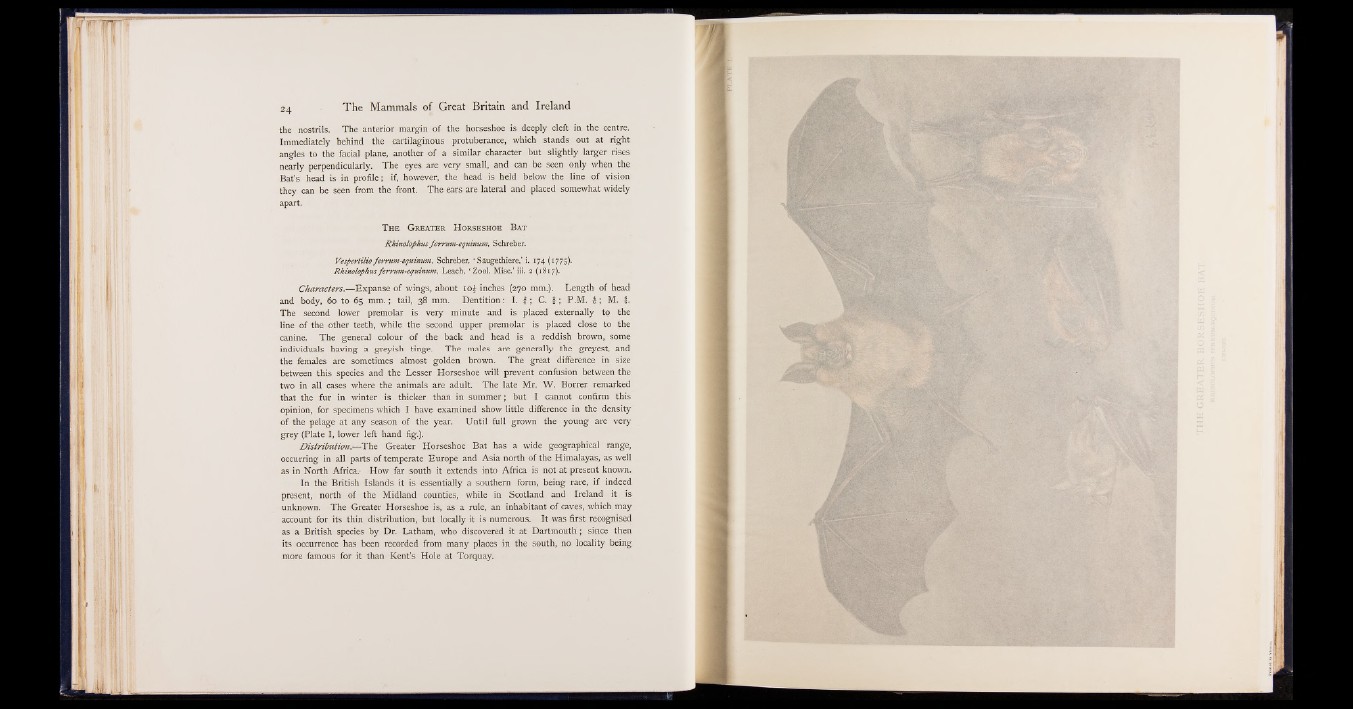
2 4 The Mammals of Groat Britain and Ireland
the nostrils. The anterior margin of the horseshoe is deeply cleft in the centre.
Immediately behind the cartilaginous protuberance, which;,;stands out at right
angles to the facial plane, another of a similar character but slightly larger rises
nearly perpendicularly. The eyes are very small, and can be seen only when the
Bat’s head is in profile; if, however, the head is held below the line of vision
they can be seen from the front. The ears are lateral and placed somewhat widely
apart.
T h e G r e a t e r H o r s e s h o e B a t
Rhinolophus ferrum-equinum, Schreber.
Vespertilio ferrum-equinum, Schreber, ‘ Saugethiere,’ i. 174 (1775).
Rhinolophus ferrum-equinum, Leach, ‘ Zool. Misc.’ iii. 2 (1817).
Characters.— Expanse of wings, about io£ inches (270 mm.). Length of head
and body, 60 to 65 mm.; tail, 38 mm. Dentition: I. £; C. #; P.M. $; M. |.
The second lower premolar is very minute and is placed externally to the
line of the other teeth, while the second upper premolar is placed close to the
canine. The general colour of the back and head is a reddish brown, some
individuals having a greyish tinge. The males are generally the greyest, and
the females are sometimes almost golden brown. The great difference in size
between this species and the Lesser Horseshoe will prevent confusion between the
two in all cases where the animals are adult. The late Mr. W. Borrer remarked
that the fur in winter is thicker than in summer; but I cannot confirm this
opinion, for specimens which I have examined show little difference in the density
of the pelage at any season of the year. Until full grown the young are very
grey (Plate I, lower left hand fig.).
Distribution.— The Greater Horseshoe Bat has a wide geographical range,
occurring in all parts of temperate Europe and Asia north of the Himalayas, as well
as in North Africa.* How far south it extends into Africa is not at present known.
In the British Islands it is essentially a southern form, being rare, if indeed
present, north of the Midland counties, while in Scotland and Ireland it is
unknown. The Greater Horseshoe is, as a rule, an inhabitant of caves, which may
account for its thin distribution, but locally it is numerous. It was first recognised
as a British species by Dr. Latham, who discovered it at Dartmouth; since then
its occurrence has been recorded from many places in the south, no locality being
more famous for it than Kent’s Hole at Torquay.